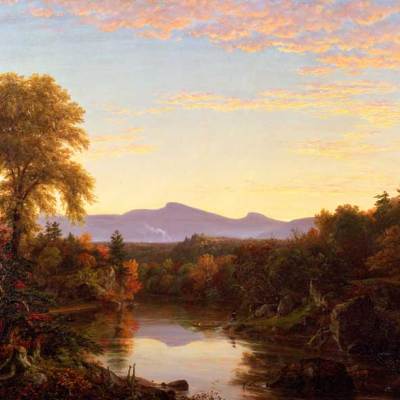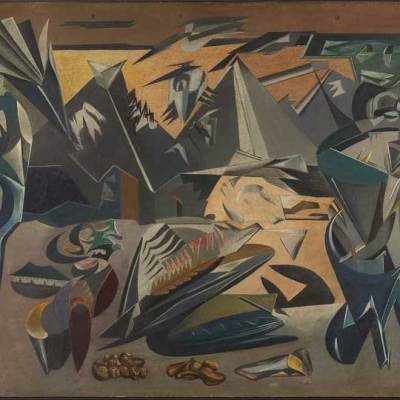Almost as if anticipating the inscrutably abstract aura of the paintings for he has become known, Serge Poliakoff’s mysterious origins are a matter of debate: some say he was born in 1900, but the majority believe it was in 1906. The general consensus, then, is that this Muscovite artist – the 13th of 14 children – left his affluent, horse-breeding home at the age of 12, earning a living as a jazz guitarist (first in the pre-revolutionary Russian capital, and later across the cafes of Europe after fleeing the bloodshed with his aunt Nadia, a singer).
Such an upbringing does not naturally prefigure the dulled, dirtied oil compositions – also known as Poliakoff’s ‘Silent Paintings’ – that are the focus of a new exhibition at London’s Timothy Taylor Gallery. It’s the first solo presentation of the abstract artist’s works in the UK for over half a century (the previous was a show at the Whitechapel Gallery in 1963), and displays his important late creations from the 1960s – paintings with gravitas that subtly take hold of your attention. As Poliakoff said himself: ‘Quand un tableau est silencieux, cela signifie qu’il est réussi’ (‘When a picture is silent, that means it’s worked’).
To be clear: ‘Silent Paintings’ is not on the same register as ‘Le Rêve des Formes’, last year’s sweeping 150-work Poliakoff retrospective at the Musée d’Art Moderne de la Ville de Paris – but it undoubtedly works, also acting as an amuse-bouche for his wider oeuvre. After all, Poliakoff’s time in London, where he studied at the Slade School of Art between 1935–37, was a brief yet pivotal moment in the young Russian’s career. While he may have settled in the French capital back in 1923, it wasn’t until after his English education that Poliakoff went on to become a major member of the second generation École de Paris.
Composition abstraite (1967), Serge Poliakoff © the Poliakoff Estate. Courtesy Timothy Taylor Gallery, London

The work on show at Timothy Taylor Gallery reflects a ramped-up, refined idea of abstraction. Composition abstraite (1967) is cleaved into two contrasting sections: one a royal blue, the other a bloodcurdling scarlet, drawn like lines of battle or where sea meets land. On closer inspection, its lightly chalked texture further evokes remnants and reminders of war. Composition abstraite (1969) is measured yet chaotic – a sheen of impurity spreads over its irregular, dimly-pigmented shapes, though Orange, jaune et vert (1964) truly exudes the rough-round-the-edges expressionism that earned Tachisme, a catch-all term for pre- and post-war non-geometric French abstraction, its reputation as the European equivalent of New York’s Abstract Expressionism.
These energetic tensions between line and surface, form and content, colour and light, are further emphasised through the gallery’s choice to hang the paintings in pairs. It suggests a cyclical nature of the works, perhaps harking back to the Catholic Church that Poliakoff’s mother was so heavily involved with, and its related chiaroscuro. It would seem remiss to describe these paintings as restrained, when their rough graininess, stark geometry and sublime palette are almost transcendent. They confirm Poliakoff as a significant post-war abstract painter.
‘Serge Poliakoff: Silent Paintings’ is at Timothy Taylor Gallery, London, until 21 February.
Related Articles
Serge Poliakoff: Silent Pictures (Caroline Rossiter)




